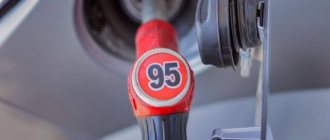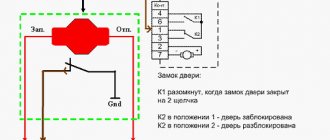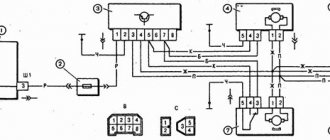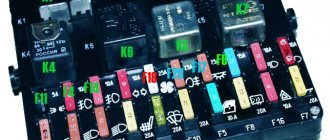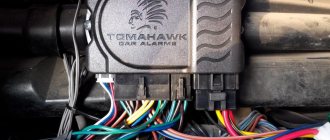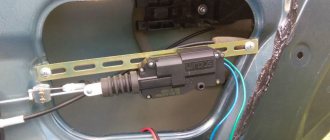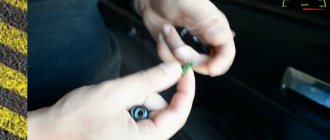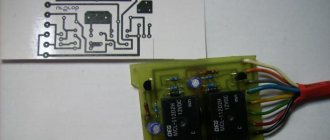Central locking is an indispensable attribute of a modern car. Many car enthusiasts practically do not use a mechanical lock to open doors.
For this reason, mechanical lock cylinders, due to corrosion and diffusion processes, literally get stuck to the lock structure, and if the central locking system malfunctions, the battery is low, the key fob or car alarm malfunctions, access to the car interior may be limited.
Signs of a central locking malfunction
The main symptoms of a central locking malfunction correspond exactly to their manifestation:
- The driver's door does not open with the key fob or key;
- The driver's door does not close with the key fob, key or button;
- opening and closing one of the doors does not work;
- central locking closes and immediately opens the doors;
- The locking is triggered spontaneously and the doors open.
In one expression, all of the listed malfunctions can be called “incorrect operation of the central locking system.”
The central locking system belongs to the category of complex electronic systems of a car; troubleshooting its faults is quite complicated, so soberly and carefully assess your ability to independently eliminate such a fault.
Video - the central locking in LADA KALINA stopped working, searching for the reason:
General recommendations
p, blockquote 43,0,0,0,0 –>
Periodically open the door with the key, even if you always use the central locking key fob, so that the door lock mechanism does not get stuck.
p, blockquote 44,0,0,0,0 –>
Do not try to warm the lock with hot water if it is frozen in winter. It's better to try an electric hair dryer. Commercial liquids for freezing at low temperatures do not always help.
p, blockquote 45,0,0,0,0 –>
Tighten the door suspension, if it wobbles, this can lead to jamming of the lock and blown fuse for its power supply.
p, blockquote 46,0,0,0,0 –>
It happens that the immobilizer does not see the key, what to do in such situations.
How can you determine which alarm system is used in a car using a key fob?
If the car windows sweat from the inside https://voditeliauto.ru/sovety-voditelej/zapotevayut-stekla-v-mashine-iznutri-chto-delat.html what to do in this case and what folk remedies can be used.
Video - repairing the central locking on a Hyundai Getz:
p, blockquote 48,0,0,0,0 –> p, blockquote 49,0,0,0,1 –>
How the system works
The central locking system includes the following main blocks and components:
- central electronic unit;
- driver's door electronic unit (can be combined with the central unit);
- electronic units for driver, passenger and rear doors (may be missing);
- push-button switches for driver, passenger and rear doors;
- limit switches for closing windows and doors;
- control units and window lift drives.
In most car models, the power window and central locking control units are connected into a single system. When closing the doors, the central locking system must poll the limit switches of all windows so as not to accidentally park the car and guard it with the windows open. Therefore, the failure to close the doors is often associated with a malfunction of the window regulator controls.
For a 2005 VW Passat, the electrical circuit for the central locking looks like this:
- Drive, buttons and limit switches of the passenger door (hereinafter referred to as Dv);
- Passenger engine control unit;
- Window lifter control unit and rear left drive;
- Rear left drive motor, switches;
- Driver's switch;
- Driver's driver's side switches;
- Driver's control unit, internal;
- Control unit for rear right door and window lifter;
- Multifunctional control unit.
- Blocker.
- Central locking drive rear right motor
- Window lifter switches and buttons.
- Fuses serving the central locking system.
This diagram does not show and label all the elements, but it is clear that the circuit is very complex, perhaps the most complex among the main electronic modules of a car.
At the same time, the central locking control circuit has the longest electrical wiring, which is distributed throughout the vehicle interior and has flexible corrugated hoses at the points of transition to the door space. Among other difficulties, car doors have maximum mobility relative to the interior; their interior space is susceptible to corrosion.
Despite the above difficulties, car models after the 2000 release have fairly reliable electronic central locking systems; their main malfunctions are often determined by mechanical breakdowns, faulty contacts, and wear on the door suspension.
How to troubleshoot
To restore the ability of the key fob to issue commands, and the alarm carried them out unquestioningly, you need to take one of the following troubleshooting methods:
Replace the battery
Removing the key fob cover, taking out the old battery and inserting a new one will probably not pose a big problem for any driver. Perhaps the remote control will immediately work as usual after this.
@drive2.ru
Run circuit diagnostics
If the first method does not work, move on to a more serious step: carefully inspect the electrical wires. You may notice a broken wire and replace it so as not to have to worry about blocking the doors in the future.
Tie the keychain
If you managed to turn off the alarm by pressing the key fob button, but the doors remained closed, you will have to reprogram the remote control itself and additional control systems. Each car model has its own rules for disabling registered key fobs and entering new data into their memory.
To perform flashing, you also need to know the model of the security device installed in the car.
If you cannot resolve the problem on your own, you will have to meet with specialists. Alarm technicians will figure out the cause of alarm failures and fix it themselves.
The main causes of central locking malfunction
The main causes of malfunction of the central electronic locking system are:
- malfunction of electrical wiring, especially in places of corrugated hoses and connectors for entering the motor (up to a quarter of all failures);
- improper adjustment and operation of limit switches, power windows, window regulators;
- incorrect adjustment or wear of the closing mechanism of the motor, wear of the suspension of the motor;
- damage to rods and plastic tips;
- malfunction of the door lock drive;
- malfunction of power window drives;
- failure of the engine control buttons;
- malfunction of the power window control buttons;
- blown fuses;
- malfunction of the electronic control units included in the central locking system.
In modern cars, they try to structurally combine electronic door controls into a single whole with drives, limit switches and control buttons.
With the combined option, the probability of failure of the central locking system is reduced significantly. This reduces repair and maintenance time. To carry out repairs, for example, the driver's door, a unit replacement (entirely) of just one central drive with a control unit and limit switches is required. This, of course, negatively affects the cost of repairs.
Independent circuit repair of the central locking system without the appropriate experience and knowledge is almost impossible. However, some typical faults can be eliminated if they are not related to damage to the electrical wiring.
Causes of problems and solutions to problems
Previously, only signs of malfunctions were considered. Now it is important to understand why they arise, who is to blame for this and what needs to be done in a given situation. Central locking failure is usually associated with:
- relay failure;
- wiring problems;
- battery;
- fuses;
- keychain;
- control device;
- actuator.
Considering the fact that there are many causes of malfunctions, each of them requires separate consideration. After all, the approach to repairing the central locking system directly depends on who was the culprit of the malfunctions. Motorists should be warned in advance. If you are not confident in your own strengths and capabilities, and do not have experience in repairing complex systems such as central locking, you should not try to repair the central locking system yourself. This is sometimes a complex procedure that requires appropriate qualifications and a clear understanding of the structure of the entire system.
Relay
A fairly common cause of malfunctions in the operation of the central locking system, when the car central locking does not open from the key fob, is the relay. Therefore, the motorist needs to check its current condition. You can do this yourself, since the procedure is not the most difficult. First you need to find the place where the relay is located. It may vary depending on the make and model of the vehicle. In some cars, the relay is installed together with other relays and fuses in a special block. But sometimes the element is located on the section of the electrical circuit that follows from the control unit. You can look at the instruction manual and find out exactly where the relay you are looking for is. Having found it, it is necessary to dismantle the device for further inspection. Checking is carried out with a multimeter. You can also disassemble the relay and check the condition of the board, which is located inside the case. If there are traces of burnt contacts, it will not be possible to restore the relay. It just needs to be changed. Experienced drivers and specialists recommend trying to close the electrical circuit directly after dismantling. If nothing has changed, all that remains is to simply throw out the old relay and put a new element in its place. It is inexpensive, but in a few minutes you can fully restore the operation of the central locking system. When choosing a new relay, it is recommended to take the old failed component with you. This will allow you to accurately select a similar device.
Wiring
Most often, electrical wiring suffers in the area that runs between the body and the door. It provides for the use of rubber corrugation, and wiring runs inside it. If it is damaged or interrupted by accident, or during active use, the central locking system will cease to function. When the circuit is open, due to the bending of the line, the contacts are closed, which allows the lock to function normally. Once it is closed, the contacts will open and the device will stop working. To solve the problem, it is recommended to follow a few simple rules.
- Open the car door. While it is open, press the close button. To do this, a rod in the form of a screwdriver or other available material is inserted into the lock latch from the end side. If everything is fine with the wiring, after such manipulation the lock should work and try to close the door
- Next you need to press the limit switch. He is in the doorway. This is necessary for the control module to record the fact that the device is closed.
- The car's security system is turned on if it has an alarm system. In this case, the door locks must be closed. If the alarm determines that the locks are closed, the driver will receive a response in the form of a sound signal.
- On the control panel, press the button to enable or disable the protection. If the door opens after pressing, pull the door handle, open the latch and slam it back. In a situation where the doors did not open, you should start looking for damage on the electrical line, that is, in the wiring.
If the central locking from the key fob does not work: troubleshooting sequence
Any repair or troubleshooting in a car must begin with checking the fuses that serve a specific system. There are three of them in the diagram below. Usually it can be more. You need to find their location using the car's instruction manual or searching on the Internet.
Video - if the central locking does not work from the alarm, then first check the fuses:
If all fuses are in good working order, proceed to determining the location of the malfunction based on its characteristic symptoms.
Central locking does not close the doors
There are several options for central locking:
- does not respond to the key fob signal at all, in this case it is necessary to check, or better yet, immediately change the key fob battery;
- does not close the door even with the lock key;
- closes and immediately opens the doors.
The last option is associated with loose closure of windows or doors. It is necessary to try to press each door sequentially, supporting it with your whole body, and at the moment of pressing, try to close the central locking.
Perhaps a foreign object has gotten into the closing area of a door; it needs to be checked. You should also check the pressure of the glass so that it fits tightly into the upper grooves.
If the central lock does not respond to the key fob and key, the wires may have broken in the area of the corrugation entering the door. If you have experience repairing electrical wiring, you can find the faulty wire and connect it.
The central locking system does not open the doors, but at the same time closes them
One option is to shift the door hanger. The lock is locked with a door latch. This type of malfunction often occurs in the trunk doors. You have to press them manually to wedge the movement of the lock drive. When you try to open the door, you should hear a click from the drive. In some cars it is almost inaudible; you have to put your ear to the door.
Central locking only closes the driver's door
Here, most likely, the malfunction is a breakdown in communication from the driver's door control unit to the central unit or other doors. You should remove the corrugated hose from the wiring transition from the driver's door to the car interior - there will be a break there.
In some car models, there is a connecting connector at the junction of the wiring into the car interior; you can check its contacts. It is also necessary to examine the electrical wiring under the door trim and all connectors.
One of the doors does not open
Possible malfunctions: damage to the electrical wiring in the corrugation or on the way to it in the cabin, malfunction of the lock drive.
Video - the central locking of the driver's door on a Skoda Fabia does not work:
The lock drive is easy to replace and is inexpensive. During replacement, the main thing is not to damage the levers, rods and plastic tips.
If you replace the central locking drive yourself, to be sure, it is better to find a mechanical diagram on the Internet, reference books, or instruction manual so that you do not forget to install any part.
How to get into a car if the key fob doesn't work
In this case, there is only one way out - use a key. But keep in mind that problems are observed only with the central locking, and the alarm, as a rule, continues to function as usual. Therefore, when you try to insert the key into the lock, the car will definitely create a cacophony.
The alarm can only be silenced using the service button by turning off the alarm manually. Look for the life-saving switch behind the instrument panel. Although, in principle, it can be located in another place. Please read the instructions in advance to be prepared for such unforeseen circumstances.
It may happen that the key will only be able to open one door. But it's better than nothing. You can leave, but just be sure to try to return the central locking to its previous working condition.
Repair of electric central locking
Over time, central locking solenoids do not tolerate low temperatures well due to high humidity, especially in spring and autumn. First they begin to jam, and then the door no longer closes or opens. The solenoids can be cleaned and lubricated, but it is better to replace them with motorized drives.
Electric central locking drive
Activators may not work or work partially on one of several doors for the following reasons:
- Damage to the circuit or poor-quality contacts in the electrical wiring.
- Relay is faulty.
- If control is carried out from the board, then it is possible that the reason is its malfunction.
- Poor contact at device terminals or damage to the drive electrical circuit.
- Wear of activator components.
- The winding has burned out.
Repairing a car's central locking system should begin by checking the non-working activators to see if they are receiving voltage. If the door lock function is activated, there should be voltage on one wire. If a signal to open is received, voltage leaves the 1st wire and appears on the 2nd. Based on the results obtained, further actions are performed: either the activator is checked and repaired in case of a malfunction, or the entire circuit is checked, correcting damaged areas. Broken wires most often occur in corrugated areas.
Sorry, there are no surveys available at this time.
Incorrect alarm installation
Often the Starline A9 signaling system does not close the doors with the key fob because the kit itself was not installed correctly.
- A transceiver with a radio antenna was placed next to metal components of the car body or next to electrical appliances. As a result, interference occurs along the signal transmission path;
- The harness from the Starline central module was intertwined with other wires (contrary to the recommended correct installation technique).
Move the transceiver, untangle the wires and lay the central module cable separately.
Reprogramming required
If the Starline alarm does not close the doors using the key fob, does not respond to commands immediately, or other malfunctions are observed, try registering the key again.
To do this, according to the instructions for the Starline security kit, model A91, you need to press the Valet key 7 times with the ignition off.
After the sound alert sounds 7 times, press keys 2 and 3 on the key fob. Hold until the siren sounds. Repeat the action with the next remote control. When finished, turn off the ignition and wait for the side lights to flash 5 times. Ready.
If you have a different alarm model, the action algorithm can be found in the technical manual.
Abnormal opening/closing of doors
In some cases, the alarm is triggered when the door is closed. In this case, the key fob may display information that the door is open. When you close it again and press the corresponding button on the key fob, the car immediately opens and the alarm goes off.
The problem is caused not so much by the system itself, but by the adjustment of the driver's door actuator. It cannot reach the standard traction, and the limit switch does not allow the central locking to open the doors. In this case, there are 2 options:
- Remove the driver's side door trim and adjust the actuator on the rod.
- Replace the two-wire activator with a similar system, but consisting of five wires. After this, you need to give him control of the central locking from the standard key fob. It is worth noting that this method is the most effective.
- After the car has been idle for a long time and the security system has been disarmed, a problem may arise when the doors automatically close immediately. The problem is solved after pressing the open button a second time.
In addition, the wiring insulation may be damaged and the fuse on the green and blue wires in the central locking connector may have burned out. The presence of a short to ground contributes to the spontaneous opening and closing of doors. The problem may also lie in the equipment being in service mode. In this case, the shock sensor will not work. In this case, the key fob will notify you of a malfunction with a signal displaying a wrench. This icon is selected by button 3 and disabled by button 2.
Central locking is an indispensable attribute of a modern car. Many car enthusiasts practically do not use a mechanical lock to open doors.
p, blockquote 1,0,0,0,0 –>
p, blockquote 2,0,0,0,0 –>
For this reason, mechanical lock cylinders, due to corrosion and diffusion processes, literally get stuck to the lock structure, and if the central locking system malfunctions, the battery is low, the key fob or car alarm malfunctions, access to the car interior may be limited.
p, blockquote 3,0,0,0,0 –>
p, blockquote 4,0,0,0,0 –>
Battery problem
Starline a91 may not lock the doors with the key fob due to the battery for three reasons:
- The unit is discharged;
- The battery was replaced with a new one;
- The battery is broken.
The cure for the last problem is to buy a new battery. The first is charging in a specialized service or at home. After replacing the unit, the key fob most often fails because it requires re-programming. We have already described above how this is done.
Why won't the lock on the trunk door close?
The fifth door of station wagons and hatchbacks may stop closing even after a minor accident and in the absence of visible damage due to skew or displacement of the lock mate . Another common cause is a broken unlock button .
To find out the cause of the breakdown, you can remove the trunk trim.
If the trunk does not lock or the fifth door in the car stops closing, the problems already described above may also occur:
- Violation of geometry (deformation of the door, hinges, displacement of the lock or response bracket, pin);
- Lock jamming (due to breakage or freezing);
- Loss of electrical contact (due to broken or shorted wiring).
If the trunk door does not close in a car with a cable-operated lock, you need to inspect the cable. When biting it, the locking tab may jam in the open position. On cars with an electric lock and automatic door closer, the reason may be in the limit switch or microswitch that determines the position of the trunk lid or the fifth door. If it sours or breaks, then the block may “think” that it is still open, and the drive of the locking element will not work.
See the table for the reasons why the trunk or the fifth door in a car does not close:
| Situation | Possible reason | What to do |
| The trunk door does not close/slams | Loops are misaligned | Adjust or straighten the hinges, returning them to the correct position |
| Parts are deformed after an accident | Align the parts and align them correctly, adjust the lock | |
| The stops (bump stops) are set incorrectly | If the damper stops, which soften the bang when closing the fifth door, have moved or are incorrectly adjusted, they need to be set to the correct position | |
| The car is parked on an uneven place and the body is skewed | Move to level ground and close the trunk | |
| The lock on the trunk door won't close | Entry of foreign objects | See if the cargo is preventing you from closing the trunk, adjust it and try again |
| Lock jammed | Clean and lubricate the lock | |
| The door closes easily and smoothly, but the lock does not work | The lock is jammed | Disassemble, clean and lubricate or replace the lock |
| The unlocking drive cable is biting | Replace the cable, as a temporary solution - manually move it and lubricate it by injecting oil into the jacket with a syringe | |
| The trunk door with central locking does not close | Broken or short-circuited wiring | Inspect and check the wiring and connectors for breaks, oxides and short circuits, eliminate them |
| Actuator failure | Replace lock solenoid | |
| Electrical problems | Inspect the electrical part of the lock (solenoid, control board) and sensors (micro switches, limit switches), replace faulty ones | |
| The power trunk door does not close using the key fob | Actuator failure | Repair or replace the lock actuator |
| The key fob battery is dead | Replace battery | |
| Key fob failure | Use a spare key fob, buy and attach a new key fob to the central locking system or alarm using a master key fob | |
| Closing drive failure | Repair or replace the drive (motor or actuator) that closes the trunk | |
| Broken or short-circuited wiring | Inspect and diagnose wires, terminals, connectors, test with a multimeter | |
| After frost, the fifth door in the car does not close | Castle freezing | Warm up and dry the lock, lubricate its moving parts |
| Icing of lock parts and seals | Clean the lock parts and contact surfaces from ice, lubricate with silicone grease |
In a situation where the trunk door did not close, but then began to work normally, you should lubricate the lock parts and adjust the door stops.
Programming automatic door opening and locking
Modern Starline security systems enable the car owner to both control door locks from a distance using key fobs, and automatically lock or unlock them when security or service options are turned on.
For example, doors are blocked when arming or when moving. Most door unlocking functions are activated automatically when certain functions are activated. But, some of them can be programmed separately. They do this using the Valet service key, the control panel or SMS commands. Follow the instructions in the user manual.
Types of castles
Central locks (CL) are divided into standard and non-standard. The last type of device is installed by the car enthusiast himself. The first one is included with the machine. The central locking synchronizes without problems with the signaling system (Starline A91, E46, Magicar and others).
Device differentiation occurs through the communication channel. There are 2 types of gradation:
- infrared;
- radiofrequency.
The first type is well protected from interference and signal scanning by hijackers. The disadvantages include the range and the need to “hit” the command from the key on the transmitter signal.
Radio frequency central locking does not have such disadvantages. However, it is easier for hijackers to consider it.
The difference lies in the type of drive used:
- Pneumatic. The signal to the “ends” of the lock is transmitted by pneumatic channels (hoses, tubes). Such systems are used in Mercedes and Volkswagen. Many other automakers have already refused to make cars with the presented central locking systems.
- Electromagnetic ones are rare. The models work like a solenoid. The signal sent through the remote control may not open the door in cold weather.
- Electromechanical. Reliable in all weather conditions. Reliable operation is ensured in frost, rain or heat.
The electromechanical control system is widely used in Hyundai, Honda and other brands.

